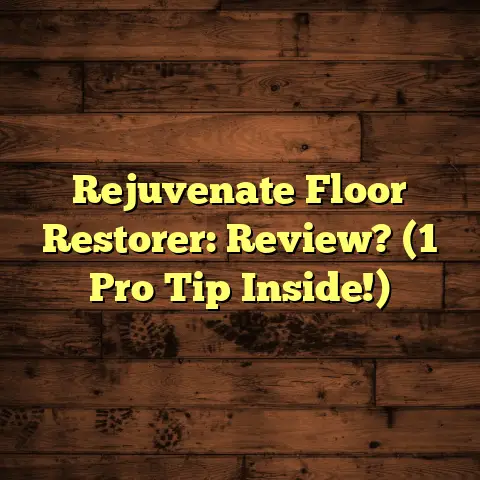Level Concrete Basement Floor (6 Fixes Needed!)
Why am I so passionate about this? Because I’ve seen firsthand how a safe and inviting basement can transform a family’s life. It’s not just about having extra space; it’s about creating a place where memories are made, kids can play freely, and families can truly connect. So, let’s dive into making that dream a reality, shall we?
Section 1: Understanding the Importance of a
Level Concrete Basement Floor
1. Family Safety and Comfort
Have you ever tripped over an uneven spot in your basement? It’s not fun, right? Especially for the little ones or grandparents. According to the National Safety Council, falls are a leading cause of injury in the home, and uneven flooring is a major culprit.
A level floor minimizes these tripping hazards, creating a safer environment for everyone. Plus, let’s be honest, a smooth, even surface just feels better underfoot. Imagine your kids playing on a soft rug in the basement, without you constantly worrying about them stumbling.
Beyond safety, a level floor enhances the overall aesthetic of your basement. It makes the space feel more finished, more inviting, and more like an actual part of your home. Think about it: would you rather spend time in a room with a wonky, uneven floor, or a space that feels clean, smooth, and well-maintained?
2. Impact on Home Value
Alright, let’s talk numbers. A finished basement can significantly boost your home’s value. According to Remodeling Magazine’s 2023 Cost vs. Value Report, a basement remodel can recoup around 70% of your investment upon resale.
But here’s the thing: a well-maintained basement is key. A cracked, uneven concrete floor screams “problem area” to potential buyers. On the other hand, a level, finished basement adds valuable square footage and makes your home more attractive to families looking for extra living space.
I’ve seen homes sell for tens of thousands more simply because the basement was finished and in good condition. It’s an investment that pays off, both in terms of enjoyment and resale value.
Section 2: Common Issues Leading to an Unlevel
Concrete Basement Floor
So, what causes these basement floors to go all wonky in the first place? Here are the usual suspects I see on the job.
1. Foundation Settling
Think of your house like a giant tree. Over time, the ground beneath it shifts and settles. This is especially true in areas with clay soil, which expands and contracts with moisture. As your foundation settles, it can cause cracks and unevenness in your concrete slab.
What are the signs of foundation settling? Keep an eye out for:
- Cracks in the walls, especially around doors and windows
- Doors and windows that stick or are difficult to close
- Sloping floors
- Water leaks in the basement
If you notice any of these signs, it’s a good idea to call in a foundation specialist. They can assess the situation and recommend the best course of action.
2. Moisture Problems
Water is concrete’s worst enemy. When water seeps into the ground around your foundation, it can cause the soil to expand and contract, leading to cracks and settling in your concrete slab. Plus, excess moisture can lead to mold and mildew growth, which is a health hazard for your family.
Proper drainage is crucial for preventing moisture problems. Make sure your gutters are clean and that downspouts direct water away from your foundation. Consider installing a French drain or sump pump if you have recurring water issues.
3. Poor Installation or Materials
Sometimes, the problem isn’t Mother Nature; it’s just plain bad workmanship. If your concrete slab wasn’t properly installed to begin with, it’s more likely to develop problems down the road. This could be due to:
- Using substandard concrete mix
- Not properly compacting the soil before pouring the slab
- Failing to use proper reinforcement (like rebar)
I once worked on a basement where the original contractor had used a concrete mix that was too watery. The slab cracked within a few years, and the homeowner had to spend a fortune to fix it. Don’t skimp on quality when it comes to concrete!
Section 3: Six Fixes for Leveling a Concrete
Basement Floor
Alright, time for the good stuff! Let’s talk about how to fix that uneven basement floor. Here are six solutions I recommend, ranging from DIY-friendly to professional-grade.
1. Self-Leveling Compound
This is a great option for minor imperfections, like small dips or unevenness. Self-leveling compound is a cement-based mixture that you pour onto the floor, and it spreads out to create a smooth, level surface.
Here’s how to tackle it as a DIY project:
- Prep the floor: Clean the concrete thoroughly, removing any dirt, debris, or loose particles. You might need to etch the concrete with a mild acid solution to help the self-leveling compound bond properly.
- Prime the floor: Apply a concrete primer to the floor. This helps the self-leveling compound adhere and prevents air bubbles from forming.
- Mix the compound: Follow the manufacturer’s instructions carefully. Use a mixing drill and a bucket to get a smooth, lump-free consistency.
- Pour and spread: Pour the self-leveling compound onto the floor, starting in the deepest areas. Use a gauge rake or spreader to distribute the compound evenly.
- Let it cure: Allow the compound to dry completely according to the manufacturer’s instructions. This could take 24-72 hours.
Family Tip: Make this a family project! Get the kids involved in cleaning the floor (with proper supervision, of course). It’s a great way to teach them about home improvement and teamwork.
2. Mudjacking (Slab Jacking)
For more significant settling, mudjacking might be the answer. This involves injecting a mixture of mud, cement, and other materials under the concrete slab to lift it back into place.
Here’s how it works:
- Drill holes: The contractor drills small holes through the concrete slab.
- Inject the mixture: A slurry of mud, cement, and other materials is pumped through the holes, filling the voids underneath the slab.
- Lift the slab: As the slurry fills the voids, it lifts the concrete slab back to its original level.
- Patch the holes: The holes are patched with concrete.
Why hire a pro? Mudjacking requires specialized equipment and expertise. It’s not a DIY project, and it’s important to hire a contractor with experience in this area. Plus, they can ensure the process is done safely and without causing further damage to your foundation.
3. Polyurethane Foam Injection
Similar to mudjacking, polyurethane foam injection involves filling voids under the slab to lift it back into place. However, instead of mud, a lightweight polyurethane foam is used.
Here’s the lowdown:
- Drill holes: Small holes are drilled through the concrete.
- Inject the foam: The polyurethane foam is injected through the holes. The foam expands and fills the voids, lifting the slab.
- Cure time: The foam cures quickly, usually within a few hours.
- Patch the holes: The holes are patched with concrete.
Why I like it: Polyurethane foam is lightweight, durable, and resistant to moisture. It’s also less invasive than mudjacking, and the process can be completed quickly, minimizing disruption to your family’s life.
4. Concrete Grinding
If you only have minor high spots or unevenness, concrete grinding might be a good option. This involves using a diamond grinder to smooth down the high spots, creating a level surface.
Here’s what you need to know:
- Rent a grinder: You can rent a concrete grinder from most tool rental stores.
- Wear safety gear: Always wear safety glasses, a dust mask, and ear protection when grinding concrete.
- Grind slowly: Start with a coarse grit diamond grinding wheel and gradually move to finer grits. Grind slowly and evenly to avoid creating dips or gouges.
- Clean up: Use a shop vacuum to remove the concrete dust.
Safety Tip: Concrete grinding creates a lot of dust, so it’s important to ventilate the area well and wear a respirator. Keep children and pets away from the work area.
5. Installing a New Concrete Overlay
For severely damaged or uneven floors, a new concrete overlay might be the best solution. This involves pouring a thin layer of new concrete over the existing slab, creating a smooth, level surface.
Here’s the process:
- Prep the floor: Clean the existing concrete thoroughly and apply a bonding agent.
- Mix the concrete: Mix the concrete overlay according to the manufacturer’s instructions.
- Pour and spread: Pour the concrete overlay onto the floor and spread it evenly with a trowel.
- Finish the surface: You can leave the concrete overlay plain, or you can add decorative finishes like stains, dyes, or stencils.
- Cure the concrete: Allow the concrete to cure properly before walking on it.
Family Project Alert! Pouring a concrete overlay can be a fun family project. Let the kids help with mixing (under supervision, of course) and decorating the surface with stencils or stamps. It’s a great way to bond and create lasting memories.
6. Professional Leveling Services
For extensive leveling work, or if you’re not comfortable tackling the project yourself, hiring a professional contractor is always a good idea. They have the experience, equipment, and expertise to get the job done right.
Here’s how to choose the right contractor:
- Get multiple quotes: Don’t just go with the first contractor you find. Get quotes from at least three different companies.
- Check references: Ask for references and call them to see what their experience was like.
- Read reviews: Check online reviews to see what other customers are saying.
- Ask questions: Don’t be afraid to ask questions about their experience, their process, and their warranty.
Red Flags: Be wary of contractors who:
- Don’t have insurance or licenses
- Ask for a large upfront payment
- Can’t provide references
- Seem evasive or unwilling to answer your questions
Section 4: Maintaining a Level Concrete
Basement Floor
Once you’ve leveled your basement floor, it’s important to maintain it to prevent future problems. Here are some tips:
1. Regular Inspections
Make it a habit to inspect your basement floor regularly for cracks, unevenness, or water leaks. The sooner you catch a problem, the easier it will be to fix.
Family Checklist:
- Check for cracks in the walls and floor.
- Look for signs of water damage (stains, mold, mildew).
- Feel for unevenness in the floor.
- Make sure your gutters and downspouts are clean.
2. Moisture Management
Moisture is the enemy, so take steps to keep your basement dry. Use a dehumidifier to maintain proper humidity levels. Repair any water leaks promptly. Ensure proper ventilation to prevent moisture buildup.
3. Preventative Measures
Take steps to prevent future problems with your basement floor. Make sure your landscaping slopes away from your foundation. Install a French drain or sump pump if you have recurring water issues. Regularly inspect and maintain your gutters and downspouts.
Conclusion
A level concrete basement floor is more than just a cosmetic upgrade; it’s an investment in your family’s safety, comfort, and well-being. It creates a space where memories can be made, kids can play freely, and families can connect.
So, take action! Choose the fix that’s right for your situation, and get to work transforming your basement into a functional and inviting space. With a little effort, you can create a basement that your family will love for years to come.





